The relationship between humans and the whitewater rivers of the Adirondack Park dates back over 8,000 years. Whitewater paddling originated with the Native Americans who carved canoes and used the water as means for trade; they were able to travel upstream by standing in a canoe and pushing the boat with a long pole. Then, in the 18th century, people from Europe arrived in the New World and began to inhabit the Adirondack whitewater riverbanks (“Hudson River Geography”, 2015). Europeans first used whitewater rivers for commercial trade which evolved into hydroelectric power and finally, recreational activities. Now, people kayak, canoe, and raft the whitewater regions for pleasure. To formulate a well-rounded perspective of today’s whitewater regions in the Adirondack Park, one must look at the development of human life along Adirondack whitewater rivers.
Now, Adirondack citizens focus more on using whitewater ecotourism to generate profit from the rivers. Ecotourism and recreational paddling generate profit that benefits the Adirondack economy and community. The purpose of this website is not only to reveal how humans use the Adirondack whitewater rivers for paddling but also the development of whitewater regions into paddling destinations and the current culture around Adirondack recreational paddling. This gives a general idea of the impact humans have on the Adirondack whitewater region as well as the success of recreational whitewater paddling.

Moose River Photographed by Anne LaBastille Provided Through the Environmental Protection Agency
Whitewater paddling is a fast-moving technical sport that offers paddlers a bigger challenge to hone their skills than flat-water does. It’s perfect for people who get a sense of accomplishment by navigating a rapid successfully, or people who like to scare themselves. Today, it’s a worldwide recreational sport, funding many commercial businesses. Many companies around the world have capitalized on the public interest and guide companies take people with varying levels of experience out on rivers. There are 13 commercial raft companies in the Adirondacks with professional guides (Jenkins).

The Falls in Keene Valley Photographed by Wildhart
The Adirondack community regulates dam releases to create the most successful whitewater paddling industry. The practice of dam releases, though initially used to transport goods, is now employed for recreational activities. The term “bubble” refers to the large volume of water that is released over a period of time into a river when a dam is opened upstream. Rafting companies can physically manipulate river water and time their trips with dam releases, because the rapids are more fun when the stage, or depth, of the river is higher. With these scheduled releases of a “bubble”, the paddling season last much longer than it used to when paddlers had to depend on spring runoff.

Brown's Brook, an Adirondack River, Photographed by Wildhart
To preserve the river quality of whitewater Adirondack rivers, both national and local governments, alongside citizen activists, have implemented river advocacy laws to address issues including pollution and water diversion for private use. The national government has created laws such as the Environmental Policy Act, the Clean Water Act, and the Electric Consumer Protection Act to monitor specific whitewater river qualities and prohibit damaging human behavior. Local governments and many commercial paddlers fight to protect the rivers. One activist group called American Rivers, based out of Washington D.C., works to clean rivers and change legislation regarding rivers. Their website claims that American Rivers had a hand in the removal of over 200 dams in America (americanrivers.org). American Whitewater also works to protect rivers and has advocated for dam removal (americanwhitewater.org). Activists have been successful in improving river quality by presenting the essential role it plays in preserving Adirondack whitewater rivers. Now, local organizations continue to implement and revise safety regulations to ensure that the people who use the whitewater rivers are as safe as the river’s future.

The Glen at the Hudson River in the Adirondacks
Paddlers have developed a key set of safety regulations and classifications that are universally recognized on the river. For a description of them go here. With the input of his peers Charlie Walbridge, the Safety Chairman of American Whitewater, developed these rules and regulations. Walbridge also developed the use of the throw-line rescue bag and the HiFloat life vest to increase the safety of paddlers (charliewalbridge.com). Simultaneously, there are rules about leave no trace (or “leave no wake” for water sports) in order to preserve the Adirondack region and to give other rafters a nice experience.
Sources
"Hudson River Geography." Cary Institute. Cary Institute of Ecosystem Studies, 2015. Web. 6 Mar. 2015.
Jenkins, Jerry, and Andy Keal. The Adirondack Atlas: A Geographic Portrait of the Adirondack Park. Syracuse, NY: Syracuse UP, 2004. Print.
For Information on Flatwater Tourism, click here
For Information on Maritime Pastimes, click here
